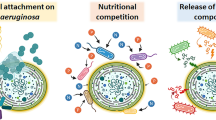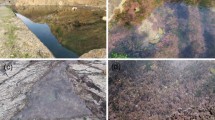Abstract
Several examples of stimulative and inhibitoryeffects of bacteria on microalgal growth areintroduced, and the importance of bacteria in algalmass culture is investigated. Diatoms are often usedas live food for planktonic larvae of sea urchin andbivalves. Monodispersed Chaetoceros ceratosporum hasbeen cultivated by using clean, high nutrient content,deep seawater (DSW). However, the growth rate and cellyield of diatoms fluctuated, to relatively largeextent, with the season that DSW was collected. Whensome bacterial strains isolated from DSW were added tothe culture, diatom growth was often stimulated and arelatively constant cell yield was obtained. Anotherdiatom species, C. gracilis, was also stimulated byadding some bacterial strains to cultures. Thepositive effect of bacteria on diatoms was observednot only for planktonic species, but also on attachedspecies. A benthic diatom, Nitzschia sp., wasstimulated by a bacterial film of Alcaligenes on thesurface of the substratum. On the other hand, a strainof Flavobacterium sp. isolated from natural seawaterduring the decline period of an algal bloom had a strongalgicidal effect on the red tide plankton,Gymnodinium mikimotoi. Recent reports demonstratethat many bacterial strains have significantalgicidal effects on many species of red tideplankton. These results indicate that bacterialeffects should be taken into account to obtain stablemass culture of food microalgae.
Similar content being viewed by others
References
Baker, K. H. & D. S. Herson, 1978. Interactions between the diatom Thallasiosira pseudonannaand as associated Pseudomonad in a mariculture system. Appl. environ. Microbiol. 35: 791–796.
Fukami, K., 1991. Interactions between microalgae and bacteria. In Simidu, U. (ed.), Marine Microorganisms and Biotechnology, Gihoudou Shuppan, Tokyo: 256–280. (in Japanese).
Fukami, K., T. Nishijima & Y. Hata, 1991a. Isolation of bacteria promoting the growth of microalgae from deep seawater and its effects. Kuroshio (Rep. Inst. Kuroshio Sphere, Kochi Univ.), special issue 5: 17–21. (in Japanese).
Fukami, K., T. Nishijima & Y. Hata, 1992a. Availability of deep seawater and effects of bacteria isolated from deep seawater on the mass culture of food microalga Chaetoceros ceratosporum. Nippon Suisan Gakkaishi 58: 931–936.
Fukami, K., T. Nishijima, H. Murata, S. Doi & Y. Hata, 1991b. Distribution of bacteria influential on the development and the decay of Gymnodinium nagasakiensered tide and their effects on algal growth. Nippon Suisan Gakkaishi 57: 2321–2326.
Fukami, K., K. Sakaguchi, M. Kanou & T. Nishijima, 1996. Effect of bacterial assemblages on the succession of blooming phytoplankton from Skeletonema costatumto Heterosigma akashiwo. In Yasumoto, T. Y. Oshima & Y. Fukuyo (eds), Harmful and Toxic Algal Blooms, Inter-Governmental Oceanographic Commission of UNESCO, Paris: 335–338.
Fukami, K., T. Sakami, Y. Ishida & the late N. Tanaka, 1989. Effect of bacterial film on the growth of the attached diatom, Nitzschia sp. In Miyachi, S., I. Karube & Y. Ishida (eds), Current Topics in Marine Biotechnology, Proceedings of the First International Marine Biotechnology Conference, Fuji Technology Press, Tokyo: 415–418.
Fukami, K., A. Yuzawa, T. Nishijima & Y. Hata, 1992b. Isolation and properties of a bacterium inhibiting the growth of Gymnodinium nagasakiense. Nippon Suisan Gakkaishi 58: 1073–1077.
Fukami, K., A. Yuzawa, K. Sakaguchi & T. Nishijima, 1995. Prevention of noxious red tide by algicidal bacteria. Proceedings of the international conference on ecological system enhancement technology for aquatic environments: 89–94.
Hainse, K. C. & R. R. L. Guillard, 1974. Growth of vitamin B12–requiring marine diatoms in mixed laboratory cultures with vitamin B12–producing marine bacteria. J. Phycol. 10: 245–252.
Imai, I., Y. Ishida & Y. Hata, 1993. Killing of marine phytoplankton by a gliding bacterium Cytophagasp., isolated from the coastal sea of Japan. Mar. Biol. 116: 527–532.
Imai, I., Y. Ishida, K. Sakaguchi & Y. Hata, 1995. Algicidal marine bacteria isolated from northern Hiroshima Bay, Japan. Fish. Sci. 61: 628–636.
Imai, I., Y. Ishida, S. Sawayama & Y. Hata, 1991. Isolation of a marine gliding bacterium that kills Chattonella antiqua(Raphidophyceae). Nippon Suisan Gakkaishi 57: 1409.
Jones, A. K., 1982. The interaction of algae and bacteria. In A. T. Bull & J. H. Slater (eds), Microbial Interactions and Communities, 1, Academic Press, London: 189–247.
Kawamura, T., T. Saido, H. Takami & Y. Yamashita, 1995. Dietary value of benthic diatoms for the growth of post–larval abalone Haliotis discus hannai. J. exp. mar. Biol. Ecol. 194: 189–199.
Matsubayashi, T., I. Maruyama, S. Kido, Y. Ando, T. Nakashima & T. Toyota, 1994. Effects of deep seawater on the growth of several species of marine microalgae. J. appl. Phycol. 6: 75–77.
Mitsutani, A., K. Takesue, M. Kirita & Y. Ishida, 1992. Lysis of Skeletonema costatumby Cytophagasp. isolated from the coastal water of the Ariake Sea. Nippon Suisan Gakkaishi 58: 2159–2169.
Nakashima, T., 1988. Effects of deep sea water on the growth of a marine diatom species Skeletonema costatum. Bull. Plankton Soc. Japan. 35: 45–55. (in Japanese with English abstract).
Nakashima, T. & T. Toyota, 1989. Artificial upwelling of deep seawater. Kaiyo Monthly 21: 618–625. (in Japanese).
Onji, M., T. Sawabe & Y. Ezura, 1995. Effect of marine bacteria isolated from Tanabe Bay on the growth of marine red tide dinoflagellate, Gymnodinium mikimotoi. Bull. Fac. Fish. Hokkaido Univ. 46: 39–46.
Riquelme, C. E., 1988. Interaction between microalgae and bacteria in coastal seawater. Doctoral thesis, Kyoto Univ., 92pp.
Riquelme, C. E., K. Fukami & Y. Ishida, 1987. Annual fluctuations of phytoplankton and bacterial communities in Maizuru Bay and their interrelationship. Bull. Japan. Soc. Microb. Ecol. 2: 29–37.
Riquelme, C. E., K. Fukami & Y. Ishida, 1988. Effects of bacteria on the growth of a marine diatom, Asterionella glacialis. Bull. Japan. Soc. Microb. Ecol. 3: 29–34.
Sakata, T., 1990. Occurrence of marine Saprospirasp. possessing algicidal activity for diatoms. Nippon Suisan Gakkaishi 56: 1165.
Sakata, T., Y. Fujita & H. Yasumoto, 1991. Plaque formation by algicidal Saprospirasp. on a lawn of Chaetoceros ceratosporum. Nippon Suisan Gakkaishi 57: 1147–1152.
Sakata, T. & K. Iwamoto, 1995. Isolation of marine algicidal microorganisms on diatom double layer agar plates. Fish. Sci. 61: 173–174.
Suminto & K. Hirayama, 1993. Relation between diatom growth and bacterial population in semi mass culture tanks of diatom. Bull. Fac. Fish., Nagasaki Univ. 74/75: 37–41.
Suminto & K. Hirayama, 1996. Effects of bacterial coexistence on the growth of a marine diatom Chaetoceros gracilis. Fish. Sci. 62: 40–43.
Tanaka, Y., 1982. The thermotolerant unicellular diatom, Chaetoceros ceratosporumOSTENFELD, as a useful feed to bivalve larvae. Bull. Natl. Res. Inst. Aquacult. 3: 31–36. (in Japanese with English abstract).
Tenjin, A. & T. Ishii, 1984. Studies on the living food for planktonic larvae of sea urchin and bivalve. Bull. Fukushima Pref. Fish Farm Exp. Stat. 1: 29–34. (in Japanese).
Yoshinaga, I., T. Kawai, T. Takeuchi & Y. Ishida, 1995. Distribution and fluctuation of bacteria inhibiting the growth of a marine red tide phytoplankton Gymnodinium mikimotoiin Tanabe Bay (Wakayama Pref., Japan). Fish. Sci. 61: 780–786.
Author information
Authors and Affiliations
Rights and permissions
About this article
Cite this article
Fukami, K., Nishijima, T. & Ishida, Y. Stimulative and inhibitory effects of bacteria on the growth of microalgae. Hydrobiologia 358, 185–191 (1997). https://doi.org/10.1023/A:1003139402315
Issue Date:
DOI: https://doi.org/10.1023/A:1003139402315




